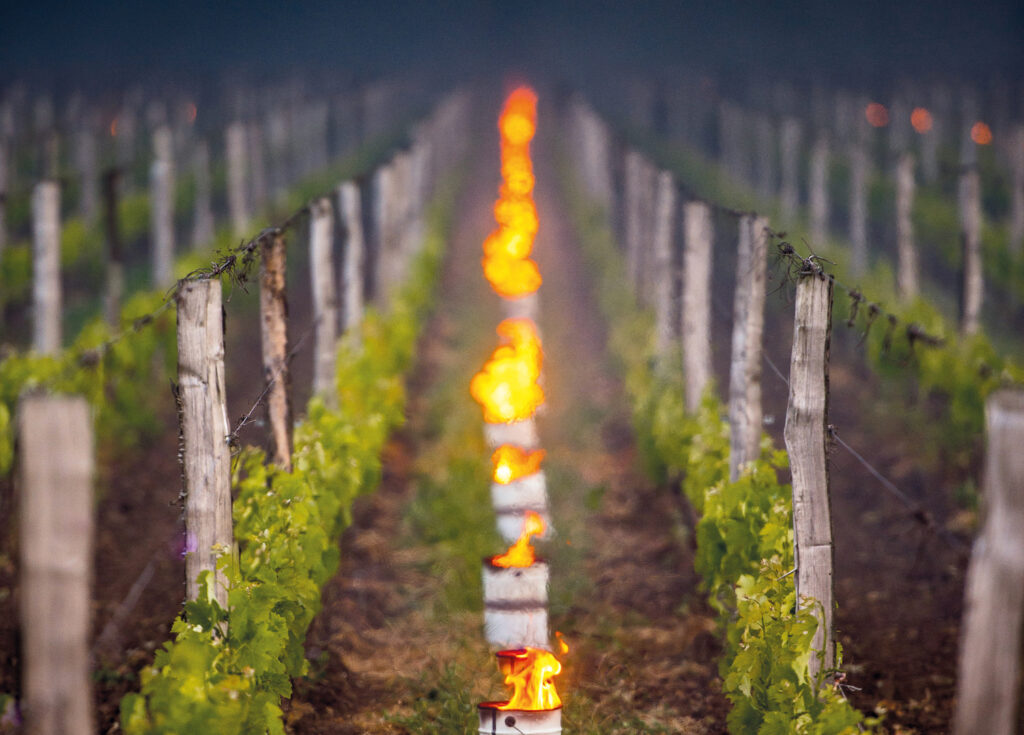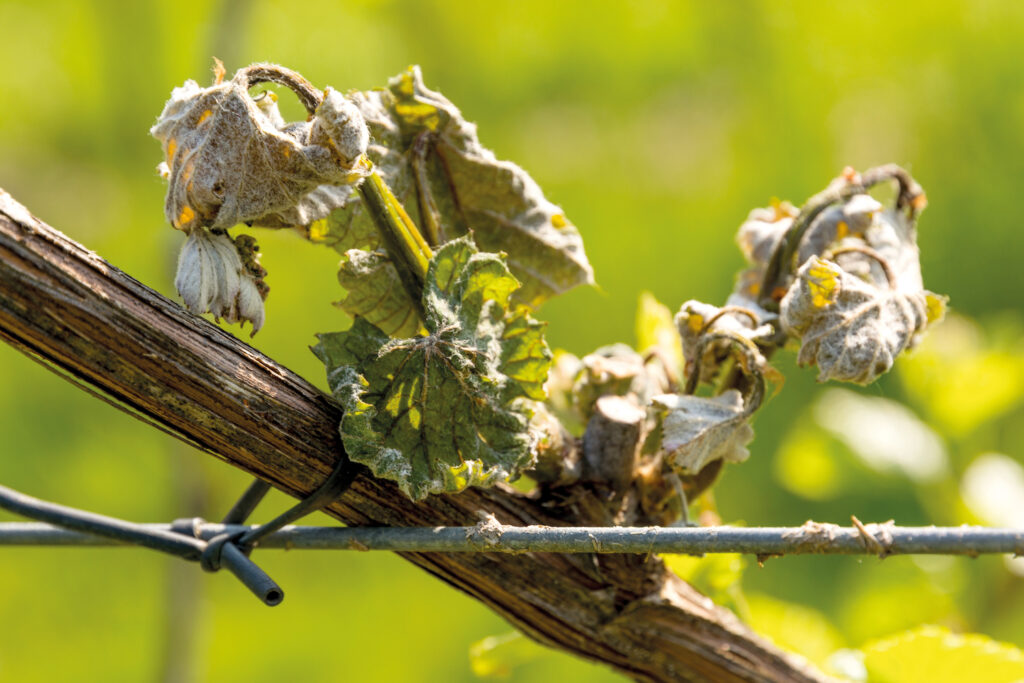The latest tech in the fight against frost risk
4th January 2023
While frost control across the pond can involve significant investments, with huge commercial vineyards even employing helicopters to force warmer air downwards, here in the UK this just can’t be justified. So, what are your options?

Dormant grapevines can tolerate winter frosts to some extent, as long as temperatures don’t drop below around 15ºC (which is pretty unlikely in the key growing regions in the more southerly areas of the UK).
But if frost hits just after bud burst, the young shoots are vulnerable to cell damage and between 20–90% of a crop can be lost as a result. Once frost damage has happened, there is little that a grower can do to mitigate the crop loss, so the only solution is to prevent the frost damage in the first place. But how can you do this?
Frost candles
Large paraffin candles, or ‘bougies’, burn at high temperatures and are designed to create air movement, which prevents a frost pocket from forming. There is, however, a risk of secondary damage due to leaf scorching.
A significant number (usually hundreds) of candles are required in order to generate enough air movement across a vineyard, which can take a long time (and a lot of hands) to light in the middle of the night.
The candles generally range from 8–14 hours’ burn time. Once the candle is burned down, traditionally the empty metal cans would then need to be disposed of; but with sustainability being such a watchword within the industry these days, some companies are now providing refillable options, such as The Crop Candle Company. Its Crop Candle Refill has an eight hour burn time and high calorific heat of 22–25,000KJ/hr. It can be added to existing Crop Candle cans, and the company says that even if you have 5–6cm remaining in the bottom of your 10–12hr candle you can place the refill on top of the existing wax to ensure your next burn will have an additional eight hours.
Frost fans
According to Vinescapes, every radiation frost event is different; different atmospheric conditions, inversion layer strengths, temperatures, length of sub-zero temperatures, soil moisture levels, and vine development stages. In general though, with a decent inversion, the company says one of its mobile frost fans on flat land can protect on average:
- 4ha of land down to -3°C
- 3ha of land down to -4°C
- 1ha of land down to -5°C.
Swift International exclusively distributes mobile FrostFans (www.frostfans.uk) which, the company says, growers can put to use 15 minutes after delivery. The machines can rotate/oscillate 0–360-degrees, and rotation speed can be set according to the conditions. Swift International has had serious interest from the UK recently, as frost has been a major factor in the past five years, mainly in regards to yield. It is crucial to have correct placement and a timely delivery of new machines so the operater knows the machine and how to set it up and standby. FrostFans can provide a plan for placement if required. There is still limited stock for supply of machines in spring 2023, the company says.

Fruit & Vine spoke to Oxfordshire-based grower Ed Mitcham, who has been using a 2013/2014 model frost fan for the last few years covering a vineyard area of 2.5ha, and is now looking to purchase an additional newer model due to expanding the vineyard to almost 5ha in size.
By having two machines, he says he can easily cover the entire vineyard, and it also gives him piece of mind should the older fan fail or break down – relying on one leaves him open to too much risk.
For him, the older fan covers only around 2ha on his particular vineyard; whereas the newer FrostFan Frost Protection 250 model should easily cover 4ha. He says he looked at the Frost Protection 650, which protects up to 6.5ha, but decided to go with the 250 model as he’ll be using it in tandem with the older fan when needed.
The newer model offers much improved features, Ed reckons. For starters, the engine is now diesel-powered with a direct drive to the fan, whereas the older version relies on belts.
Digital information screens mean ease of use, and temperature sensors are all in-built, while other modernisations, which include being able to adjust the angle of the boom rather than just the position of the head, help to improve performance and efficiency.
The auto-start mechanism allows you to set parameters so that once the temperature drops to a certain level, the fan will self-start, and then turn itself off once the temperature has risen to the pre-set level.
This is ideal for growers like Ed who don’t live onsite, as it provides peace of mind. He says it means you can watch the temperature dropping from home, and can see the fan has activated, buying some valuable sleep as it can all be managed remotely.
Ed explains that with any frost protection options, you don’t really want to be in the vineyard at 2/3am, so for him, reliability is key.
When asked how mobile these fans actually are, he commented his is really manoeuvrable, which he feels is invaluable when having to combat the cold air drift, the direction of which can change on a dime. Blowing the fans with the cold air drift direction rather than against it is key to efficient and effective frost control, so if the direction changes it’s important to adjust the
frost fan accordingly.
He describes it as like towing a trailer, and reckons that while you wouldn’t want to be towing it on a road for long, for short journeys it’s ideal. Set-up is quick and easy, and the fan can be up and running within minutes once it’s been relocated.
When the frosts are particularly harsh, Ed uses a combination of frost fan and bougies, particularly at times when the drive belts are nearing the end of their life and the old fan might have to be running for longer than anticipated – but with the newer model, the direct drive engine design means this scenario will no longer be a concern so Ed won’t have to rely on bougies so much as a back-up.
With both used and new vineyard machinery being in such high demand and short supply,
Ed is looking forward to receiving his updated FrostFan model via Swift International in time
for next spring.
Sprinklers
It may sound counter-intuitive, but running sprinkler systems through the night when a late frost threatens causes water to freeze over any tender growth, and an exothermic reaction allows the water to give off latent heat as it freezes, trapping this heat between the vine and the ice to create a microclimate. While the amount of heat generated is small, it can be enough to protect the susceptible tissue as long as the frost doesn’t last for more than a few hours.
It’s important that sprinkler systems are already in place before the frost threat can be realised, and that they are appropriately positioned with the correct water hydraulic calculations to continually douse all vines.
Amongst other sprinkler options, Plantex UK says it can provide a cost-effective and water efficient irrigation and frost protection with a bespoke control and automation system that suits your individual requirements and budget, which will target specific zones, has a low investment cost per hectare and can be combined with Plantex’s drip irrigation system to irrigate and fertigate vineyards.
Protecting against both advection and radiation frosts down to -8ºC, sprinkler systems are a low noise and environmentally-friendly option.
Heated cables
Companies such as Gaia provide heated cables which are wrapped around the fruiting cane and the heat is then conducted into the sap of the cane. Because sap is a good conductor of heat, it is able to evenly distribute this to the new growth internally. One benefit of this type of frost protection system is its low labour requirement, which is a consideration that helps to outweigh the initial investment of time and money. Cables can be professionally installed or self-installed, with the cables being backed with a 20-year warranty. The cables are controlled by a thermostat which ensures heat is distributed when and where it is required, to maintain the crop at an ideal temperature.
The latest innovation to hit the UK viticulture scene is the Frolight Infrared System which is exclusively available via Plantex UK. The electrical system is based on infrared lighting tubes which transmit radiant heat, and it automatically switches on and off at pre-set temperatures, meaning no more labour-intensive nights.
The infrared modules are uniformly distributed, resulting in more efficient energy distribution. By using infrared radiation as a heat transfer medium, there are no major energy losses, regardless of wind or rain – ensuring guaranteed protection.
In terms of installation, separate modules are joined by waterproof connectors, so the system is highly flexible and can be extended indefinitely according to the specific needs of the vineyard.
Vineyard monitoring/frost alerts
For all types of frost protection, anticipating the risk of frost is key. Keeping an eye on the local weather report isn’t enough for vineyards, as frost risk can vary from field to field, so more precise monitoring is the most effective way to keep one step ahead; particularly when relying on a more time- and labour-intensive frost solution like bougies.
Companies such as Sencrop offer precision weather stations which are connected to a collaborative weather application, helping you to detect when crops are at risk so you can act accordingly. According to Sencrop, to measure the risk of frost, you need an accurate and complete weather solution, which includes a humidity sensor and a thermometer.
The wet bulb temperature is the temperature value in contact with water in a liquid state. In other words, it is the value that takes into account the humidity in suspension (air humidity). There are two methods for obtaining this value precisely:
The capillary measurement is done with a dedicated physical sensor (e.g. Comsag, Pessl, Weenat…). In this sensor, the wet bulb temperature is calculated by a thermometer surrounded by a water-soaked lace.
The measurement by algorithmic calculation is calculated from the temperature and hygrometry measurements (e.g. Sencrop, Davis, Meteus, Pessl and so on).
Sencrop has chosen this second method, by integrating an algorithm from the most recent scientific publications on the subject of wet bulb temperature.
Monitoring the wet temperature makes it possible to anticipate the minimum temperature that can be reached, and thus to act at the right time.
